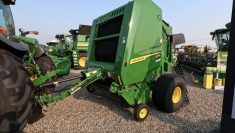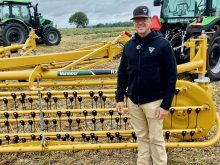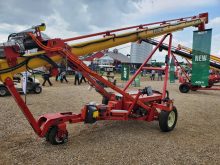Arc welding is an indispensable tool on farms and ranches across Canada. When an implement, machine or gate is broken and time is short, most people in agriculture have the tools and know-how to weld it where it sits, or if necessary, bring it into a workshop for welding.
With or without formal training in arc welding, most farmers and ranchers know the basics about welding safety, often learned through hard lessons.
While not watching an arc, covering exposed skin and not picking up hot metal with your hands are obvious, what might not be obvious is the risk of electrocution or severely damaging equipment that can come with the output from a standard arc welder.
Read Also

China’s grain imports have slumped big-time
China purchased just over 20 million tonnes of wheat, corn, barley and sorghum last year, that is well below the 60 million tonnes purchased in 2021-22.
Because of the types of welding used in most agricultural applications and the challenging work environment, farmers and ranchers are often at a greater risk from the electrical hazards associated with arc welding than full-time welders in dry shops.
The purpose of this column is to better inform the agricultural community of these hazards and to explain some practices that can make arc welding safer.
Arc welding machines come in two basic types: the plug-in style and the mobile engine driven generator. In some respects, the electrical hazard from a plug-in welding machine is no different than any other electrical equipment in a workshop.
The proper installation of the input side of the machine and routine inspection of plugs, receptacles and cords are basically the same as a drill-press operating from similar power.
Both engine-driven and plug-in welding machines may provide an auxiliary power outlet, such as 115 or 230 VAC, for convenience.
These outlets are used to operate electric tools that you may need close to the job. In wet or damp locations, these outlets require GFCI protection, just like any other electrical outlet.
Where welding machines differ from other equipment is the ability to provide a high-current output, or secondary circuit, of up to hundreds of amps.
The welding machine is isolated from the electrical supply and can provide an output of up to 80 V, although some older models produce higher voltage. This is the maximum voltage across the main output terminals that a person can be exposed to if they contact the electrode while also in contact with the workpiece.
The intention is that this secondary welding circuit be completed as an isolated closed loop system with two cables.
- Electrode lead — It is the secondary circuit conductor transmitting energy from the power source to the electrode holder, gun or torch.
- Workpiece lead — It is the secondary circuit conductor that is attached to the workpiece by the return current clamp and completes the welding circuit. These are commonly and incorrectly referred to as the “ground cable” and the “ground clamp.”
If the body of a person using a welding machine comes in electrical contact with the workpiece and the electrode (or bare cable), enough voltage is available to cause current to flow through their body. This is an electric shock.
Only a very small amount current flow, about 5/1000 of an amp (or five mA), can lead to a painful electric shock. Less than about 25 mA can cause muscles to “freeze up,” which prevents a person from being able to let go of objects. Breathing and the heart muscle may stop if that much current passes through the chest. Death by electrocution is very likely with any current flow through the chest of less than 1,000 mA (or one amp).
There are many variables in the severity of an electric shock, such as the duration and the type of current (AC versus DC).
One key variable that protects people from the shock is the electrical resistance of the human skin. If the skin is soaked with water or sweat or if the skin is broken by a cut, this can critically lower the body’s resistance and allow more current to flow.
Another key factor is the amount of voltage available to move the electrons (current flow). A standard arc welding machine with upwards of 80 V has more than enough to kill a person, especially when that person is damp and in contact with the work (or even on damp ground or concrete). When damp, the current will easily flow through fabric or even leather gloves.
Unfortunately, there have been far too many cases of welder electrocutions in Canada in the past few years. These cases all have common circumstances, including the welder inadvertently contacting the live electrode when changing it or repositioning themselves.
If you are arc welding, especially with a “stick welder” (SMAW) in a damp or hot environment, you should always wear dry personal protective equipment (PPE), isolate your body from the work or the earth with a dry rubber mat and fit your machine with a voltage reduction device (VRD). Remember, with the SMAW process the electrode holder is always live, even when the electrode is being manually reloaded.
A VRD lowers the voltage present to less than about 12 V, and when you strike the arc, it automatically boosts the voltage to the level required for welding. These units can detect the higher resistance of the human body (than the welding electrode), preventing the electric shock.
VRD technology is available built into certain models of new machines or as an aftermarket unit. Recently, the CSA Standard for Welding Safety (CSA W117.2:19) was updated to require a VRD for welding under certain conditions, such as those illustrated above. Consult the standard for more details.
Stray welding current (SWC) is a fault condition where the welding current goes though unintended conductors and back to the return terminal of the machine. The SWC problem most often occurs when the welder neglects to place the return current clamp and work-piece lead as close as possible to the point of welding.
This SWC can run through and damage bearings, gears and electrical systems on equipment. In buildings. the current will run through copper grounding wires and other electrical components. One SWC event can potentially cost thousands of dollars in repairs. There have also been cases in Canada where SWC damage has caused electrocutions by severely damaging wiring.
Conestoga College in Cambridge, Ont., has created videos about SWC that are publicly available on its YouTube channel. Readers are encouraged to use these videos to help visualize SWC.
Jim Galloway teaches welding technology at Conestoga College in Cambridge, Ont. He also volunteers on several CSA technical committees, including CSA W117.2 — Welding Safety.















